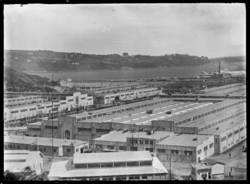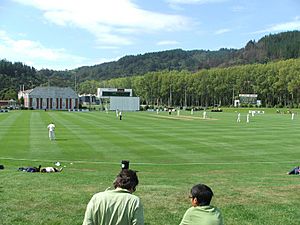New Zealand and South Seas International Exhibition facts for kids
Quick facts for kids New Zealand and South Seas International Exhibition |
|
|---|---|

The Government Tourist Court at the exhibition
|
|
| Overview | |
| BIE-class | Unrecognized exposition |
| Name | New Zealand and South Seas International Exhibition |
| Area | 6.5 ha |
| Visitors | 3,200,498 |
| Location | |
| Country | New Zealand |
| City | Dunedin |
| Venue | Logan Park |
| Timeline | |
| Opening | 17 November 1925 |
| Closure | 1 May 1926 |
The New Zealand and South Seas International Exhibition was a big event, like a world's fair, held in Dunedin, New Zealand. It ran from November 17, 1925, to May 1, 1926. This exhibition celebrated New Zealand and the beautiful South Seas region. It was the third time Dunedin had hosted such a large event, with earlier ones in 1865 and 1889. Over 3 million people visited this exciting exhibition!
Contents
What Was the Exhibition Like?
The exhibition was built on land that was created at Logan Park. This area was once a tidal bay called Pelichet Bay, which had a lake named Lake Logan. To make enough space for the exhibition, the lake was drained, and the land was prepared.
Amazing Buildings and Attractions
A talented architect named Edmund Anscombe designed many wonderful buildings for the exhibition. These buildings were arranged around a central area, with a large domed hall as the main feature. The entire exhibition covered about 16 acres (6.5 hectares). A new tree-lined road, now called Anzac Avenue, was built to connect the exhibition grounds to the city center.
The exhibition had lots of fun things to see and do! There was an amusement park with a quarter-mile long scenic railway. Visitors could also enjoy restaurants and tearooms. Many different parts of New Zealand had their own displays, showing off what they had to offer. Countries like the United Kingdom, Canada, Australia, and Fiji also had special "courts" or sections to showcase their cultures and products.
Opening Day and Visitors
The Governor-General, Sir Charles Fergusson, officially opened the exhibition in November 1925. It stayed open until the middle of the next year. Even though New Zealand's population at the time was only about 1.25 million people, an incredible 3 million visitors came to the exhibition! On its very last day, a record 83,935 people attended, showing how popular it was right up to the end.
To remember this special event, the New Zealand Post Office released a set of three unique stamps. These stamps were designed by H Linley Richardson. They were among the first commemorative stamps ever issued by New Zealand. They were also one of the few New Zealand stamps printed on colored paper.
What Remains Today?
Not much of the original exhibition site or buildings are left today. The main areas that remain are Logan Park itself and Anzac Avenue.
The Former Art Gallery
The only building still standing from the exhibition is its former art gallery. After the exhibition closed, a kind person named Sir Percy Sargood and his family bought the building. They then gave it to the city to be used as an art gallery. This building was home to the Dunedin Public Art Gallery until 1996, when a new gallery was built in the city center.
Some parts of the exhibition buildings were sold and moved to other places. For example, a small domed structure is now part of an art gallery in Brighton, south of Dunedin. After the Dunedin Public Art Gallery moved in 1996, the old building was made shorter. This allowed for more space for the nearby University Oval cricket ground. Today, the remaining parts of the building are used by the New Zealand Academy of Sport and Sports Medicine New Zealand as a gym, training area, and offices.
This former gallery building is very important. It is the only structure left from any of the big International Fairs held in New Zealand in the late 1800s and early 1900s. It's also one of only about eight such buildings left from world fairs around the globe from that time! The building was designed by Edmund Anscombe, who was a key person in bringing the exhibition to Dunedin. He became the official architect for the exhibition in 1924. The building is recognized as a Category I heritage site by Heritage New Zealand.
The Former Aquarium
There were plans to build an aquarium at the exhibition, but there wasn't enough money from the usual sources. So, George Howes (entomologist) and others started a private company called Aquarium Ltd. Their goal was to run an aquarium at the exhibition.
After the exhibition ended, Aquarium Ltd. closed down. The city then took over the aquarium building. Later, the Otago Lawn Tennis Association bought it. The actual aquarium tanks were moved to the Dunedin Botanic Garden, along with a fernery from the exhibition. These tanks were used to house fish until 1933.




